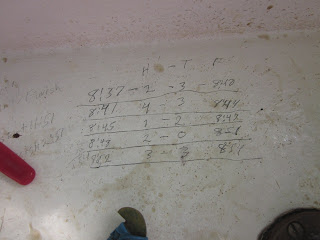How many endlines are there, anyway?
A buoy survey has been underway since last fall, where observers on lobster boats run tracklines up and down the coast in state-controlled waters outside the whale exemption area. These "sliver waters" are areas where lobstermen fishing multiple traps to a buoy must use sinking groundline in order to comply with the federal whale regulations. DMR is using a buoy survey to assess the number of vertical lines in the sliver waters. A GPS unit is attached to a laptop, giving the location of each counted buoy and associated endline over a full year.
 |
| I put my GPS in a Ziploc to keep the spray/moisture off the unit. |
Counting buoys is NOT rocket science, but it does involve a great deal of caffeine. Every month since last August, I have sat on the back deck of a boat, generally in passable weather (though some of the winter months were iffy), with a laptop on my lap, hitting F1-Enter each time I see a buoy within 100 yards off the port side.
And if that weren't exciting enough, there are some times of the year where an entire trackline, often 10 miles or longer, will have only 5 buoys along its length, because fishing effort is elsewhere -- say, 20 miles offshore, or tight along the shoreline, depending on the season. Let's just say this is some of the toughest field work I have ever been involved with -- important as it is, it's so hard to stay awake! I joke with the captains about bringing a cribbage board along, but in reality, he has to stay alert and on the trackline, and I have to peel my eyelids back and remember to hit F1-Enter each time I see a buoy inside 100 yards. We really can't do much else while we're "on effort", so my challenge has been, Hmm, how do I stay awake, alert, and in focus during this lulling boat ride?
Well, I take pictures, of pretty boats and coastlines:
 |
| Friendship sloop off Pemaquid |
 |
| Mt. Washington, MLK Day 2011 |
I have also been known to write draft reports for our derelict fishing gear grant, or to compose a letter to my sister. (I can touch type, so it's easy to watch for buoys as I tap away without looking at the keyboard, a handy skill when the keyboard's covered by a towel to keep the spray from hitting it). I also sing. A couple of the captains have XM radio and play the '80s channels, so I know a lot of the songs. (Yes, I am that old!) I must say I'm glad the roar of the diesel running at 15 knots drowns out any of my croaking so the cap doesn't have to suffer through it.
Speaking of which, earplugs are a must for me on these trips. I am amazed by the fact that most lobstermen I know do NOT wear hearing protection, shrugging it off and saying, "My hearing's gone already," and chalking it up to an occupational hazard. I was kind of impressed the other day when I saw a young captain in Cape Porpoise hop out of his pick-up at 6am, whistling a rock-n-roll tune, wearing noise-cancelling headphones on his temple. Nice to see some preventive maintenance.
The best part of this project is the mornings -- early mornings on the coast of Maine are without peer.
 |
| heading out of Cushing |
 |
| Cape Porpoise |
 |
| Tenants Harbor |
 |
| York in the winter |
Another project we're working on is the Trawling-Up Experiment.
In this effort, the DMR has designed a project to get at the question, "What would happen if lobstermen currently fishing their traps as singles or pairs were made to trawl up their gear in order to reduce the number of vertical lines?" If you've been following the whale rules at all, you know that one of the possible regulations will be to reduce the number of buoy lines to reduce the risk of entanglement to whales.
So we found a few lobstermen in zones C & D to try it on for size -- take 50 of your traps and rig them in longer trawls of 3, 5, 7 and 10 traps, and then compare the effort, catch and gear loss to a comparison set of 50 normally rigged pairs or single traps. They have to keep a logbook, so I went out with them on their first haul-back to answer any questions that might come up as they log the info.
 |
| Jeff entered the info straight into the logbook. |
 |
| Mike wrote it down on the dash and then transferred it after each string. |
 |
| Captain Jeff & Dusty prepare to set a 7-trap trawl. |
Collaborators-are-us, and it's been a great few months of getting out with various boats along this incredibly beautiful coastline. Thanks to all the participating lobstermen, and thanks to DMR for including us in these projects. I might do another blog after all is said and done, and the State has a proposal ready for the TRT in January. All this data ought to help!






